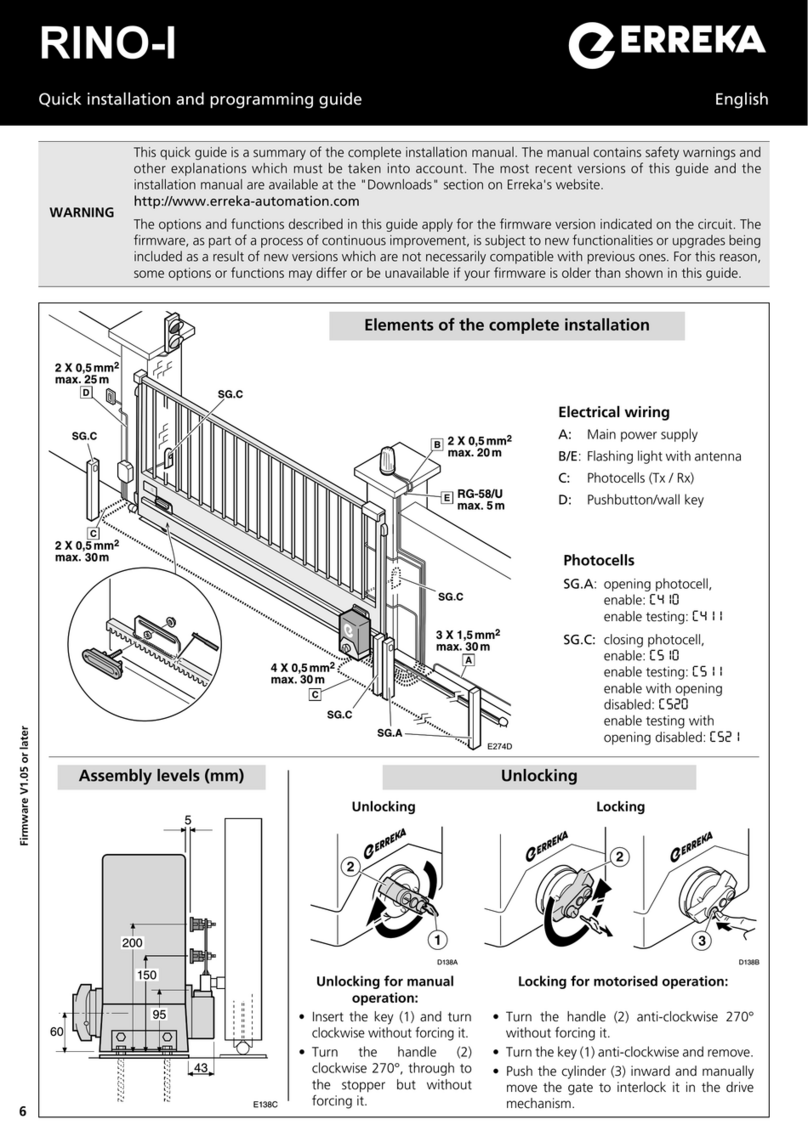
21
Tech. Support Menu ( + + ) (I)
Door Handling *
Door Handling is determined by
standing your back to the
hinges. The side to which the
door normally opens (right or
left) is the opening sense.
1.1.- Setup Menu
1.1.1.- Door Learn Mode
1.1.2.- Factory Reset Restore default parameters
1.1.3- Setup Wizard Guided door configuration
1.2.- Basic Functions
1.2.1- Select Model
• Low Energy Speeds and forces limited according to
Standard EN 16005
•FullEnergy No speed and force limitations. Safety
sensors (EN 16005)
-Standard Standard swing door configuration
-Fire door Comply with fire regulations (EN
14637)
1.2.2.-Type Of Arm Define the type of arm installed
• Articulated - Push Arm
• Slide - Pull Arm
• Slide - Push Arm
1.2.3.-
Direction Of Travel Define the direction of travel
• Inwards
•Outwards
1.2.4.-
Opener Fixed To Define the operator's location
•Lintel
•Door
1.2.5.-
Door Handling* Define opening direction
• Right
•Left
1.2.6.- Door Details Define weight and width (Obligatory
for LOW ENERGY)
• Door Weight (kg) 50 to 250 kg, def. 50 Kg
• Door Width (mm) 700 to 1.400 mm, def. 700 mm
1.2.7.- Electric Lock
• Type Define if it has electro lock or not
-Electric Strike
-Maglock
-Disabled Door with no electro lock
• Voltage Define the power supply voltage
-12V
-24V
• Opening Delay 0 to 10.000 msec, def. 0 msec
• Opening Force 0 to 5, def. 0
• Test Define if the electro lock has a test
signal
-NO
-NC
-Disabled No test
RIGHT
LEFT
LEFT
RIGHT
1.3.- Advanced Functions
1.3.1.- Door Sync
• Select Door Define who leads the movements
-M1 Master (Leader) 1
-S1 Slave 1
•DoorSync
-Enable
·Disabled
· Enabled
-Sync Distance 0 to 45º, def. 0º
• Interlock Define interlock operation
-Enable
·Disabled
· Enabled
-Type
·Standard See “SAT Menu” in the “Installation
Guide”.
· Smart See “SAT Menu” in the “Installation
Guide”.
-Interlock Time 0 to 300 seg, def. 0 seg
1.3.2.- Automatic Mode Define operation in automatic mode
• Configuration Default configuration
-Normal Mode See “SAT Menu” in the “Installation
Guide”.
-Semi Auto Mode See “SAT Menu” in the “Installation
Guide”.
-Accessible toilets See “SAT Menu” in the “Installation
Guide”.
• Closing Device
-Motor Closing Closing with motor according to
parameters configured from selector
-Spring Closing Closing with spring. Engine released
and with passive brake
• Push&Go mode
See “SAT Menu” in the “Installation
Guide”. Def. Disabled. Degrees: 0 to
45º, def.: 0º
• Push&Close mode See “SAT Menu” in the “Installation
Guide”. Def. Disabled.
1.3.3.- Manual mode
• Normal mode
• Servo Assist mode 0 to 5, def.: 0
1.3.4.- Entrapment
• Sensitivity Level
1 to 10, def.: 5
(1 very sensitive, and 10 not very
sensitive)
• Sensitivity mode
-Standard See “SAT Menu” in the “Installation
Guide”.
-Extra Safe See “SAT Menu” in the “Installation
Guide”.
• Spring Closing
-Enabled
-Disabled
(...)
































